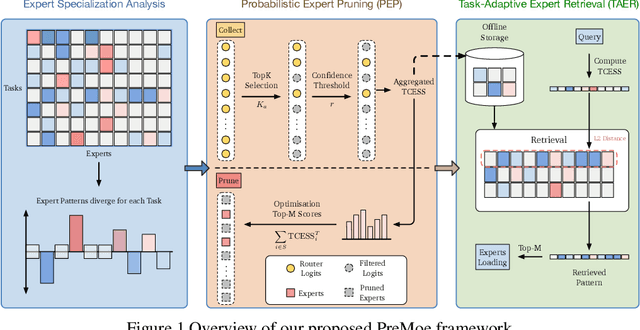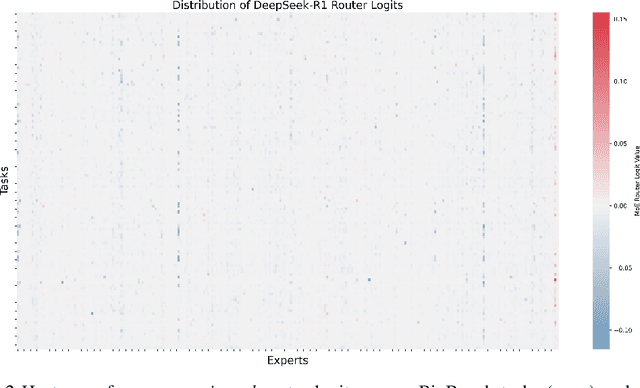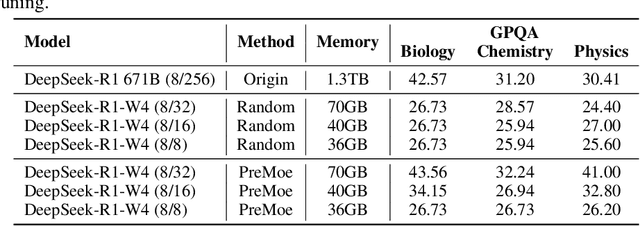Sinno Jialin Pan
MetaDefense: Defending Finetuning-based Jailbreak Attack Before and During Generation
Oct 09, 2025Abstract:This paper introduces MetaDefense, a novel framework for defending against finetuning-based jailbreak attacks in large language models (LLMs). We observe that existing defense mechanisms fail to generalize to harmful queries disguised by unseen attack templates, despite LLMs being capable of distinguishing disguised harmful queries in the embedding space. Based on these insights, we propose a two-stage defense approach: (i) pre-generation defense that detects harmful queries before response generation begins, and (ii) mid-generation defense that monitors partial responses during generation to prevent outputting more harmful content. Our MetaDefense trains the LLM to predict the harmfulness of both queries and partial responses using specialized prompts, enabling early termination of potentially harmful interactions. Extensive experiments across multiple LLM architectures (LLaMA-2-7B, Qwen-2.5-3B-Instruct, and LLaMA-3.2-3B-Instruct) demonstrate that MetaDefense significantly outperforms existing defense mechanisms, achieving robust defense against harmful queries with seen and unseen attack templates while maintaining competitive performance on benign tasks. Code is available at https://github.com/ws-jiang/MetaDefense.
PreMoe: Lightening MoEs on Constrained Memory by Expert Pruning and Retrieval
May 23, 2025



Abstract:Mixture-of-experts (MoE) architectures enable scaling large language models (LLMs) to vast parameter counts without a proportional rise in computational costs. However, the significant memory demands of large MoE models hinder their deployment across various computational environments, from cloud servers to consumer devices. This study first demonstrates pronounced task-specific specialization in expert activation patterns within MoE layers. Building on this, we introduce PreMoe, a novel framework that enables efficient deployment of massive MoE models in memory-constrained environments. PreMoe features two main components: probabilistic expert pruning (PEP) and task-adaptive expert retrieval (TAER). PEP employs a new metric, the task-conditioned expected selection score (TCESS), derived from router logits to quantify expert importance for specific tasks, thereby identifying a minimal set of critical experts. TAER leverages these task-specific expert importance profiles for efficient inference. It pre-computes and stores compact expert patterns for diverse tasks. When a user query is received, TAER rapidly identifies the most relevant stored task pattern and reconstructs the model by loading only the small subset of experts crucial for that task. This approach dramatically reduces the memory footprint across all deployment scenarios. DeepSeek-R1 671B maintains 97.2\% accuracy on MATH500 when pruned to 8/128 configuration (50\% expert reduction), and still achieves 72.0\% with aggressive 8/32 pruning (87.5\% expert reduction). Pangu-Ultra-MoE 718B achieves 97.15\% on MATH500 and 81.3\% on AIME24 with 8/128 pruning, while even more aggressive pruning to 4/64 (390GB memory) preserves 96.95\% accuracy on MATH500. We make our code publicly available at https://github.com/JarvisPei/PreMoe.
Reinforcing Compositional Retrieval: Retrieving Step-by-Step for Composing Informative Contexts
Apr 15, 2025Abstract:Large Language Models (LLMs) have demonstrated remarkable capabilities across numerous tasks, yet they often rely on external context to handle complex tasks. While retrieval-augmented frameworks traditionally focus on selecting top-ranked documents in a single pass, many real-world scenarios demand compositional retrieval, where multiple sources must be combined in a coordinated manner. In this work, we propose a tri-encoder sequential retriever that models this process as a Markov Decision Process (MDP), decomposing the probability of retrieving a set of elements into a sequence of conditional probabilities and allowing each retrieval step to be conditioned on previously selected examples. We train the retriever in two stages: first, we efficiently construct supervised sequential data for initial policy training; we then refine the policy to align with the LLM's preferences using a reward grounded in the structural correspondence of generated programs. Experimental results show that our method consistently and significantly outperforms baselines, underscoring the importance of explicitly modeling inter-example dependencies. These findings highlight the potential of compositional retrieval for tasks requiring multiple pieces of evidence or examples.
KVTuner: Sensitivity-Aware Layer-wise Mixed Precision KV Cache Quantization for Efficient and Nearly Lossless LLM Inference
Feb 06, 2025



Abstract:KV cache quantization can improve Large Language Models (LLMs) inference throughput and latency in long contexts and large batch-size scenarios while preserving LLMs effectiveness. However, current methods have three unsolved issues: overlooking layer-wise sensitivity to KV cache quantization, high overhead of online fine-grained decision-making, and low flexibility to different LLMs and constraints. Therefore, we thoroughly analyze the inherent correlation of layer-wise transformer attention patterns to KV cache quantization errors and study why key cache is more important than value cache for quantization error reduction. We further propose a simple yet effective framework KVTuner to adaptively search for the optimal hardware-friendly layer-wise KV quantization precision pairs for coarse-grained KV cache with multi-objective optimization and directly utilize the offline searched configurations during online inference. To reduce the computational cost of offline calibration, we utilize the intra-layer KV precision pair pruning and inter-layer clustering to reduce the search space. Experimental results show that we can achieve nearly lossless 3.25-bit mixed precision KV cache quantization for LLMs like Llama-3.1-8B-Instruct and 4.0-bit for sensitive models like Qwen2.5-7B-Instruct on mathematical reasoning tasks. The maximum inference throughput can be improved by 38.3% compared with KV8 quantization over various context lengths.
CMoE: Fast Carving of Mixture-of-Experts for Efficient LLM Inference
Feb 06, 2025Abstract:Large language models (LLMs) achieve impressive performance by scaling model parameters, but this comes with significant inference overhead. Feed-forward networks (FFNs), which dominate LLM parameters, exhibit high activation sparsity in hidden neurons. To exploit this, researchers have proposed using a mixture-of-experts (MoE) architecture, where only a subset of parameters is activated. However, existing approaches often require extensive training data and resources, limiting their practicality. We propose CMoE (Carved MoE), a novel framework to efficiently carve MoE models from dense models. CMoE achieves remarkable performance through efficient expert grouping and lightweight adaptation. First, neurons are grouped into shared and routed experts based on activation rates. Next, we construct a routing mechanism without training from scratch, incorporating a differentiable routing process and load balancing. Using modest data, CMoE produces a well-designed, usable MoE from a 7B dense model within five minutes. With lightweight fine-tuning, it achieves high-performance recovery in under an hour. We make our code publicly available at https://github.com/JarvisPei/CMoE.
FuseGPT: Learnable Layers Fusion of Generative Pre-trained Transformers
Nov 21, 2024



Abstract:Generative Pre-trained Transformers (GPTs) have demonstrated remarkable performance across diverse domains through the extensive scaling of model parameters. Recent works observe the redundancy across the transformer blocks and develop compression methods by structured pruning of the unimportant blocks. However, such straightforward elimination will always provide irreversible performance degradation. In this paper, we propose FuseGPT, a novel methodology to recycle the pruned transformer blocks to further recover the model performance. Firstly we introduce a new importance detection metric, Macro Influence (MI), to detect the long-term influence of each transformer block by calculating their loss of information after removal. Then we propose group-level layers fusion, which adopts the parameters in layers of the unimportant blocks and injects them into the corresponding layers inside the neighboring blocks. The fusion is not one-off but through iterative parameter updates by lightweight group-level fine-tuning. Specifically, these injected parameters are frozen but weighted with learnable rank decomposition matrices to reduce the overhead during fine-tuning. Our approach not only works well on large language models but also on large multimodal models. The experiments have shown that, by using modest amounts of data, FuseGPT can outperform previous works in both perplexity and zero-shot task performance.
State Chrono Representation for Enhancing Generalization in Reinforcement Learning
Nov 09, 2024



Abstract:In reinforcement learning with image-based inputs, it is crucial to establish a robust and generalizable state representation. Recent advancements in metric learning, such as deep bisimulation metric approaches, have shown promising results in learning structured low-dimensional representation space from pixel observations, where the distance between states is measured based on task-relevant features. However, these approaches face challenges in demanding generalization tasks and scenarios with non-informative rewards. This is because they fail to capture sufficient long-term information in the learned representations. To address these challenges, we propose a novel State Chrono Representation (SCR) approach. SCR augments state metric-based representations by incorporating extensive temporal information into the update step of bisimulation metric learning. It learns state distances within a temporal framework that considers both future dynamics and cumulative rewards over current and long-term future states. Our learning strategy effectively incorporates future behavioral information into the representation space without introducing a significant number of additional parameters for modeling dynamics. Extensive experiments conducted in DeepMind Control and Meta-World environments demonstrate that SCR achieves better performance comparing to other recent metric-based methods in demanding generalization tasks. The codes of SCR are available in https://github.com/jianda-chen/SCR.
Improving the Generalization of Unseen Crowd Behaviors for Reinforcement Learning based Local Motion Planners
Oct 16, 2024



Abstract:Deploying a safe mobile robot policy in scenarios with human pedestrians is challenging due to their unpredictable movements. Current Reinforcement Learning-based motion planners rely on a single policy to simulate pedestrian movements and could suffer from the over-fitting issue. Alternatively, framing the collision avoidance problem as a multi-agent framework, where agents generate dynamic movements while learning to reach their goals, can lead to conflicts with human pedestrians due to their homogeneity. To tackle this problem, we introduce an efficient method that enhances agent diversity within a single policy by maximizing an information-theoretic objective. This diversity enriches each agent's experiences, improving its adaptability to unseen crowd behaviors. In assessing an agent's robustness against unseen crowds, we propose diverse scenarios inspired by pedestrian crowd behaviors. Our behavior-conditioned policies outperform existing works in these challenging scenes, reducing potential collisions without additional time or travel.
Overcoming Negative Transfer by Online Selection: Distant Domain Adaptation for Fault Diagnosis
May 25, 2024



Abstract:Unsupervised domain adaptation (UDA) has achieved remarkable success in fault diagnosis, bringing significant benefits to diverse industrial applications. While most UDA methods focus on cross-working condition scenarios where the source and target domains are notably similar, real-world applications often grapple with severe domain shifts. We coin the term `distant domain adaptation problem' to describe the challenge of adapting from a labeled source domain to a significantly disparate unlabeled target domain. This problem exhibits the risk of negative transfer, where extraneous knowledge from the source domain adversely affects the target domain performance. Unfortunately, conventional UDA methods often falter in mitigating this negative transfer, leading to suboptimal performance. In response to this challenge, we propose a novel Online Selective Adversarial Alignment (OSAA) approach. Central to OSAA is its ability to dynamically identify and exclude distant source samples via an online gradient masking approach, focusing primarily on source samples that closely resemble the target samples. Furthermore, recognizing the inherent complexities in bridging the source and target domains, we construct an intermediate domain to act as a transitional domain and ease the adaptation process. Lastly, we develop a class-conditional adversarial adaptation to address the label distribution disparities while learning domain invariant representation to account for potential label distribution disparities between the domains. Through detailed experiments and ablation studies on two real-world datasets, we validate the superior performance of the OSAA method over state-of-the-art methods, underscoring its significant utility in practical scenarios with severe domain shifts.
Decomposing Label Space, Format and Discrimination: Rethinking How LLMs Respond and Solve Tasks via In-Context Learning
Apr 11, 2024



Abstract:In-context Learning (ICL) has emerged as a powerful capability alongside the development of scaled-up large language models (LLMs). By instructing LLMs using few-shot demonstrative examples, ICL enables them to perform a wide range of tasks without updating millions of parameters. However, the precise contributions of demonstrations towards improving end-task performance have not been thoroughly investigated in recent analytical studies. In this paper, we empirically decompose the overall performance of ICL into three dimensions, label space, format, and discrimination, and we evaluate four general-purpose LLMs across a diverse range of tasks. Counter-intuitively, we find that the demonstrations have a marginal impact on provoking discriminative knowledge of language models. However, ICL exhibits significant efficacy in regulating the label space and format which helps LLMs to respond in desired label words. We then demonstrate this ability functions similar to detailed instructions for LLMs to follow. We additionally provide an in-depth analysis of the mechanism of retrieval helping with ICL and find that retrieving the most semantically similar examples notably boosts model's discriminative capability.
 Add to Chrome
Add to Chrome Add to Firefox
Add to Firefox Add to Edge
Add to Edge